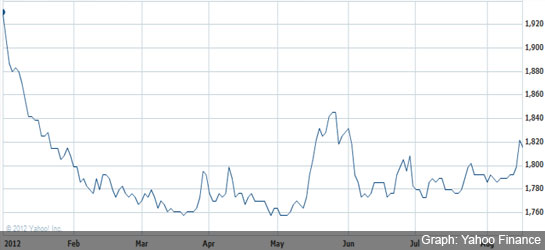
Measures taken last Friday by the Colombian government to stem the rise of the Peso have caused a flurry of debate in the Bogota financial press over the past week.
The steps are geared towards reducing the inflow of U.S. dollars that have swelled around Colombia and many other emerging markets as a result of the Federal Reserve’s expansionary monetary stimulus, making each dollar less valuable and boosting the value of local currencies where they are being invested. This in turn has placed great pressure on export industries in Colombia such as flower and textiles producers, who struggle to sell their expensive goods abroad.
Many commentators praised the Colombian government for shunning capital controls that would restrict foreign investment in favour of the market-friendly technique of reducing the amount of dollars in circulation by buying large amounts of the currency.
Rupert Stebbings, Managing Director of Celfin Capital Colombia welcomed the “common sense” measures on the Portafolio website. He warned against repeating the capital controls implemented between 2006-2008 that were “badly thought through, failed to have the desired effect and brought into question Colombia’s claims to be a free-market economy”.
Data showing that the Colombian peso had depreciated more than any currency in the world over the 45 days to the end of trading on Wednesday was a welcome justification for the government’s actions. As soon as that news was braking, however, the announcement of a $600 billion second wave of quantitative easing by the U.S. Federal Reserve pushed the peso to its highest daily jump in ten weeks on Thursday.
The Federal Reserve’s move was scathingly referred to as “throwing money out of a helicopter” by the Brazilian finance minister and alarmed some analysts in Bogota.
Mauricio Reina, a researcher at the Fedesarrollo think tank opined on Friday that the government’s measures are not effective enough and either short-term capital controls or a major fiscal adjustment similar to those being announced in Europe are needed for the Colombian Peso to ride out a “perfect storm”. This storm was emerging from a “sea of greenbacks” that is likely to only get bigger still (further weakening the Colombian currency) as an even balance of political power in the United States makes pumping more money into their economy a more attractive type of stimulus than politically-controversial budget cuts.
Exchange rates are increasingly becoming the major issue in global economics. As part of the G20 meeting in South Korea later this month the United States will attempt to encourage China to revalue its currency to make its exports more expensive. The meeting will be held against the backdrop of a World Trade Organization warning that measures to control exchange rates around the world to boost exports run the risk of provoking direct protectionism.

